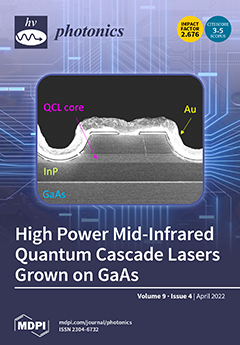The determinant of a Mueller matrix
M plays an important role in both polarization algebra and the interpretation of polarimetric measurements. While certain physical quantities encoded in
M admit a direct interpretation, the understanding of the physical and geometric significance of the determinant
[...] Read more.
The determinant of a Mueller matrix
M plays an important role in both polarization algebra and the interpretation of polarimetric measurements. While certain physical quantities encoded in
M admit a direct interpretation, the understanding of the physical and geometric significance of the determinant of
M (
) requires a specific analysis, performed in this work by using the normal form of
M, as well as the indices of polarimetric purity (IPP) of the canonical depolarizer associated with
M. We derive an expression for
in terms of the diattenuation, polarizance and a parameter proportional to the volume of the intrinsic ellipsoid of
M. We likewise establish a relation existing between the determinant of
M and the rank of the covariance matrix
H associated with
M, and determine the lower and upper bounds of
for the two types of Mueller matrices by taking advantage of their geometric representation in the IPP space.
Full article





